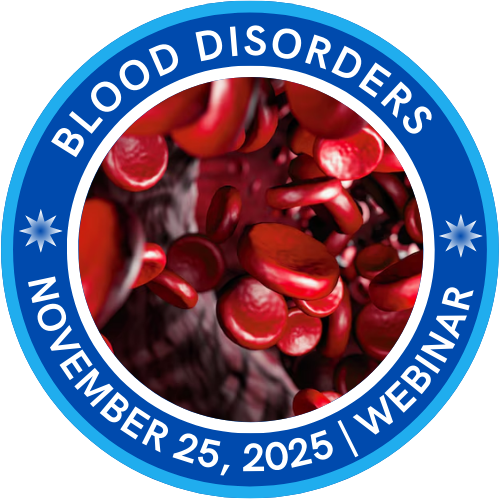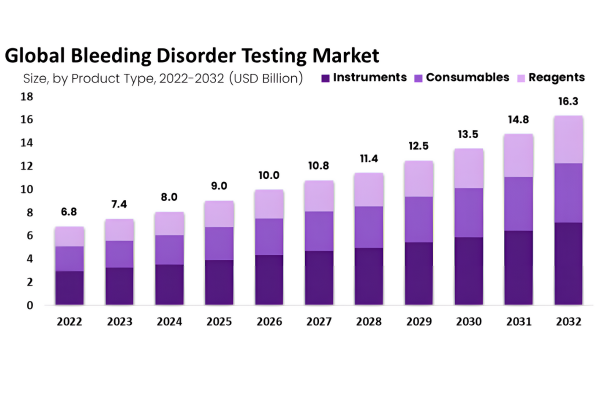"Decoding Blood Disorders: Diagnosis to Cure"
Welcome to the Webinar on Blood Disorders which is going to be held on November 25, 2025 through Online. A vital platform bringing together clinicians, researchers, healthcare professionals, and students dedicated to understanding and advancing the diagnosis, treatment, and management of hematological conditions. We are honored to host this insightful gathering focused on a range of disorders including anemia, leukemia, lymphoma, hemophilia, and clotting abnormalities. This event aims to highlight the latest research developments, therapeutic innovations, and clinical practices that are transforming patient care in hematology. With contributions from distinguished speakers and experts in the area, we look forward to a dynamic exchange of knowledge that will inspire collaboration and foster advancements in blood disorder treatment and awareness.
Blood disorders are medical conditions that affect the components of blood, including red blood cells, white blood cells, platelets, and plasma. These disorders can disrupt the normal functioning of the circulatory system and range from mild to life-threatening. Common types include anemia, which involves a deficiency of red blood cells or hemoglobin; leukemia and lymphoma, which are cancers of the blood and lymphatic system; hemophilia, a genetic disorder that impairs the blood’s ability to clot; and thrombocytopenia, characterized by a low platelet count. Causes can be genetic, nutritional, infectious, or related to other diseases and medications. Early diagnosis and proper treatment, such as medication, blood transfusion, or bone marrow transplant, are crucial in managing these conditions. Ongoing research and medical advancements continue to improve outcomes and offer hope for those affected by blood disorders.

Blood disorders are a group of medical conditions that affect the components of blood—red blood cells, white blood cells, platelets, and plasma. These disorders can disrupt the body’s ability to carry oxygen, fight infections, or control bleeding. Common blood disorders include anemia, which results from a lack of healthy red blood cells; leukemia and lymphoma, which are cancers of the blood and lymphatic system; hemophilia, a genetic disorder affecting blood clotting; and thalassemia, a hereditary condition that impacts hemoglobin production. Causes can range from genetic mutations and nutritional deficiencies to infections and exposure to certain toxins. Advances in medical science have led to improved diagnostics, targeted therapies, bone marrow transplants, and even gene-editing techniques like CRISPR to treat or manage these conditions. Ongoing research and increased awareness continue to play a crucial role in improving outcomes and the quality of life for individuals living with blood disorders.
Hematologic diseases are disorders that affect the blood and blood-forming organs, including the bone marrow, lymph nodes, and spleen. These conditions can impact the production, function, or quality of red blood cells, white blood cells, platelets, and plasma. Common hematologic diseases include anemia, hemophilia, leukemia, lymphoma, multiple myeloma, and thalassemia. These disorders may be inherited, acquired, or associated with other diseases such as autoimmune disorders or infections. Symptoms can range from fatigue, infections, and bleeding issues to more severe complications like organ damage or cancer. With advancements in diagnostics and treatment—including bone marrow transplantation, immunotherapy, targeted drug therapies, and gene editing—many hematologic diseases are now more manageable or even curable. Ongoing research and early diagnosis play a vital role in improving patient outcomes and enhancing the quality of care in the field of hematology.
Nemia treatment focuses on addressing the underlying cause of the condition, which occurs when the body lacks enough healthy red blood cells or hemoglobin to carry adequate oxygen to tissues. Depending on the type and severity of anemia, treatment options vary. For iron-deficiency anemia, the most common form, iron supplements and dietary changes rich in iron, vitamin B12, and folic acid are recommended. In cases of vitamin-deficiency anemia, supplements of vitamin B12 or folate may be prescribed. Aplastic anemia or chronic disease-related anemia may require blood transfusions, bone marrow transplants, or medications that stimulate red blood cell production. Sickle cell anemia and thalassemia may be managed with specialized treatments such as hydroxyurea, gene therapy, or regular transfusions. Advances in medical research, including targeted therapies and gene-editing techniques, are opening new possibilities for effective and long-term anemia management.
Red blood cell (RBC) disorders are conditions that affect the quantity, shape, or function of red blood cells, which are essential for carrying oxygen throughout the body. When these cells are abnormal or insufficient, it can lead to fatigue, weakness, shortness of breath, and other health complications. Common RBC disorders include anemia (such as iron-deficiency anemia, vitamin B12 deficiency, and aplastic anemia), sickle cell disease, where cells become abnormally shaped and cause blockages in blood flow, and thalassemia, a genetic disorder that affects hemoglobin production. Other conditions like polycythemia vera involve an overproduction of red blood cells, increasing the risk of blood clots. Diagnosis often involves blood tests, genetic screening, and bone marrow analysis. Treatments depend on the specific disorder and may include dietary supplements, medications, blood transfusions, or in severe cases, bone marrow transplants. Ongoing research continues to improve therapeutic options and patient outcomes in managing these disorders
Platelet disorders are medical conditions that affect the number or function of platelets, which are small blood cells crucial for blood clotting and wound healing. These disorders can lead to either excessive bleeding or unwanted clotting, depending on whether platelet levels are too low (thrombocytopenia) or too high (thrombocytosis), or if the platelets don’t function properly. Common platelet disorders include immune thrombocytopenic purpura (ITP), heparin-induced thrombocytopenia (HIT), and essential thrombocythemia. Symptoms often include easy bruising, frequent nosebleeds, prolonged bleeding from cuts, or, in some cases, dangerous clot formation. Diagnosis typically involves complete blood counts, platelet function tests, and bone marrow examinations. Treatment varies based on the cause and severity and may include corticosteroids, immunoglobulin therapy, platelet transfusions, or medications to regulate platelet production. Advances in hematology and immunotherapy are contributing to better outcomes for individuals with platelet disorders.
Hemoglobinopathies are a group of inherited blood disorders caused by abnormalities in the structure or production of hemoglobin—the protein in red blood cells that carries oxygen throughout the body. The most common types include sickle cell disease and thalassemia, both of which can lead to chronic anemia, fatigue, pain, and organ complications. In sickle cell disease, the red blood cells become rigid and crescent-shaped, leading to blockages in blood flow, while in thalassemia, the body produces abnormal or insufficient hemoglobin, causing ineffective red blood cell production. These conditions are often diagnosed in early childhood through blood tests or genetic screening. Treatment strategies may involve regular blood transfusions, iron chelation therapy, pain management, and in some cases, bone marrow or stem cell transplants. Recent advances such as gene therapy and CRISPR-based editing offer promising future cures for these lifelong disorders. Early diagnosis and comprehensive care are essential for improving the quality of life in affected individuals.
Genetic blood mutations refer to inherited or acquired changes in the DNA that affect the production, structure, or function of blood cells. These mutations can lead to a wide range of hematologic conditions, including sickle cell anemia, thalassemia, hemophilia, and certain types of leukemia and myelodysplastic syndromes. Inherited mutations are passed down from parents and often affect proteins like hemoglobin or clotting factors, while acquired mutations may develop later in life due to environmental factors, aging, or exposure to toxins. These mutations can disrupt normal blood cell development and function, causing symptoms like anemia, excessive bleeding, or increased risk of infections and cancers. Advances in genetic testing and molecular diagnostics now allow for earlier and more precise detection of these conditions. Innovative treatments, including gene therapy, CRISPR gene editing, and targeted therapies, are paving the way for personalized medicine and potential cures for many of these disorders.
Iron metabolism disorders are conditions that affect the body’s ability to absorb, store, or utilize iron properly—an essential mineral required for producing hemoglobin and supporting various metabolic processes. These disorders can lead to either iron deficiency or iron overload. Iron-deficiency anemia is the most common type and results from inadequate iron intake, poor absorption, or chronic blood loss, leading to symptoms like fatigue, weakness, and pale skin. On the other hand, iron overload disorders such as hereditary hemochromatosis cause excessive iron accumulation in organs like the liver, heart, and pancreas, potentially resulting in organ damage if left untreated. Diagnosis involves blood tests to check serum ferritin and transferrin saturation levels, along with genetic screening in suspected hereditary cases. Treatment varies depending on the disorder and may include iron supplements, dietary changes, or in the case of iron overload, therapeutic phlebotomy or iron-chelating agents. Understanding and managing iron metabolism is vital for maintaining healthy blood function and preventing long-term complications.
Blood clotting disorders, also known as coagulation disorders, are conditions that affect the body’s ability to form blood clots properly. These disorders can result in either excessive bleeding or abnormal clot formation. Bleeding disorders, such as hemophilia A and B and von Willebrand disease, occur when certain clotting factors are missing or defective, leading to prolonged bleeding after injuries, spontaneous internal bleeding, or excessive menstrual bleeding. On the other hand, clotting disorders like deep vein thrombosis (DVT), pulmonary embolism (PE), and thrombophilia involve an increased tendency to form dangerous clots, which can block blood vessels and cause serious complications. Causes can be genetic, acquired, or related to underlying health conditions. Diagnosis typically involves coagulation tests, genetic testing, and imaging studies. Treatment may include clotting factor replacement therapy, anticoagulants, or antiplatelet medications, depending on the condition. Early detection and proper management are essential to prevent life-threatening outcomes and improve quality of life for affected individuals.a
Rare blood diseases are uncommon but often serious disorders that affect the blood's cells, proteins, or clotting mechanisms. These conditions can be inherited or acquired, and many are chronic, complex, and potentially life-threatening. Examples include paroxysmal nocturnal hemoglobinuria (PNH), a disorder causing red blood cell destruction; Diamond-Blackfan anemia, which affects bone marrow function; Evans syndrome, an autoimmune condition targeting red blood cells and platelets; and hereditary spherocytosis, which leads to fragile, sphere-shaped red blood cells. Due to their rarity, these diseases are often underdiagnosed and poorly understood, making research and awareness crucial. Diagnosis may require specialized blood tests, genetic screening, and bone marrow analysis. Treatment varies widely and may include immunosuppressants, blood transfusions, bone marrow transplants, or emerging gene therapies. Global collaboration in research and healthcare access is vital for improving outcomes and providing hope to those living with these rare and often overlooked conditions.
Hemoglobin F (fetal hemoglobin) induction therapies are treatment strategies aimed at increasing the production of fetal hemoglobin (HbF) in individuals with certain blood disorders, particularly sickle cell disease and beta-thalassemia. Hemoglobin F is the form of hemoglobin naturally found in fetuses and newborns, which is gradually replaced by adult hemoglobin after birth. However, in individuals with abnormal or deficient adult hemoglobin, boosting HbF levels can significantly reduce disease symptoms and complications. Increasing HbF helps to prevent sickling of red blood cells in sickle cell disease and improves oxygen-carrying capacity in thalassemia. Common HbF-inducing agents include hydroxyurea, which has been the gold standard for decades, as well as newer options like decitabine and butyrate derivatives. Additionally, gene therapy and CRISPR-Cas9 gene editing are emerging as promising tools to reactivate the natural production of HbF by modifying specific genes involved in hemoglobin switching. These therapies offer hope for safer, more effective long-term management of hemoglobinopathies.
Hereditary hemochromatosis (HH) is a genetic disorder that causes the body to absorb and store too much iron from the diet. Over time, this excess iron builds up in vital organs such as the liver, heart, pancreas, and joints, potentially leading to serious complications like liver disease, diabetes, heart problems, arthritis, and fatigue. The most common form of HH is linked to mutations in the HFE gene, particularly the C282Y and H63D variants. Symptoms often appear in midlife and can be vague or mistaken for other conditions, making early diagnosis crucial. HH is typically diagnosed through blood tests measuring serum ferritin and transferrin saturation, followed by genetic testing if iron overload is confirmed. Treatment focuses on phlebotomy (regular blood removal) to reduce iron levels, along with lifestyle adjustments such as avoiding iron supplements, alcohol, and vitamin C (which increases iron absorption). With early detection and proper management, individuals with hereditary hemochromatosis can live healthy, normal lives.
Hemophilia A and B are rare, inherited bleeding disorders caused by a deficiency of specific clotting factors in the blood, which are essential for normal blood clotting. Hemophilia A results from a lack of clotting factor VIII, while Hemophilia B is due to a deficiency in factor IX. Both conditions are typically passed down through families in an X-linked recessive pattern, primarily affecting males. Individuals with hemophilia experience prolonged bleeding after injuries, surgeries, or even spontaneously, especially into joints and muscles, leading to pain and potential joint damage over time. Diagnosis is made through clotting factor assays, and treatment focuses on replacement therapy—infusions of the missing clotting factors. Recent advances include extended half-life factor products, non-factor therapies like emicizumab, and ongoing research into gene therapy, which offers hope for long-term correction of the disease. With proper management and early intervention, people with Hemophilia A and B can lead active, fulfilling lives.
Coagulation disorders are conditions that affect the blood's ability to form clots properly, leading to either excessive bleeding or abnormal clotting. These disorders can be inherited or acquired, and they disrupt the complex process involving platelets, clotting factors, and blood vessels. Common bleeding disorders include Hemophilia A and B, caused by deficiencies in clotting factors VIII and IX respectively, and von Willebrand disease, which affects a protein that helps platelets stick to blood vessel walls. On the opposite end, clotting disorders like deep vein thrombosis (DVT), pulmonary embolism (PE), and antiphospholipid syndrome increase the risk of dangerous blood clots. Symptoms may include frequent nosebleeds, easy bruising, prolonged bleeding, or swelling and pain in the limbs. Diagnosis often involves blood tests such as prothrombin time (PT), activated partial thromboplastin time (aPTT), and platelet function tests. Treatment depends on the specific disorder and may include clotting factor replacement, anticoagulants, or lifestyle modifications to reduce risk factors. Early detection and proper management are key to preventing complications and improving quality of life.
Thrombophilia is a medical condition characterized by an increased tendency for the blood to form abnormal clots, a process known as hypercoagulability. This condition can be inherited or acquired and significantly raises the risk of developing serious complications such as deep vein thrombosis (DVT) and pulmonary embolism (PE). Common inherited forms include Factor V Leiden mutation, prothrombin gene mutation, and protein C, protein S, or antithrombin deficiencies. Acquired thrombophilia can result from conditions such as antiphospholipid syndrome, prolonged immobility, surgery, cancer, or use of hormone therapy. While many people with thrombophilia may never develop clots, others may experience recurrent or unusual clotting events. Diagnosis typically involves blood tests, genetic screening, and thorough evaluation of personal and family history. Management focuses on reducing clotting risks through anticoagulant therapy, lifestyle changes, and in some cases, long-term monitoring. Early detection and preventive care are essential in minimizing life-threatening outcomes associated with this condition.
Our webinars are thoughtfully designed to deliver value to a wide range of individuals. Whether you're looking to grow your skills, explore new opportunities or gain insights from experts, here's who will benefit most from attending:
If you're aiming to advance in your career or stay updated with the latest trends in your field, this webinar is perfect for you. Gain actionable insights and learn from industry experts.
Professors, scholars, and students presenting findings or exploring the latest research in their field and individuals looking for collaboration opportunities.
Discover strategies, tools, and techniques to scale your business, enhance productivity, and achieve your goals. This is your chance to learn from real-world success stories.
Are you curious about new concepts or looking to bridge the gap between academia and industry? Our webinars provide practical knowledge that goes beyond textbooks.
Stay ahead of the curve! If you're passionate about the topic and want to understand the latest innovations, trends, or developments, you'll find immense value here.
In a world where knowledge is power, webinars have emerged as one of the most accessible and impactful ways to learn, grow and connect. Don't miss the chance to learn, grow and connect in ways that truly matter.
Webinars are often hosted by industry experts, thought leaders, and innovators. Attending gives you direct access to their insights, strategies, and expertise that you can immediately apply in your personal or professional life.
The digital world evolves rapidly. Webinars provide up-to-date information on the latest trends, tools, and techniques, ensuring you stay ahead of the curve in your industry or area of interest.
Webinars aren't just passive presentations they're dynamic and interactive. Participate in live Q&A sessions, answer polls, and share your thoughts with like-minded participants.
Webinars connect you with professionals, experts, and enthusiasts from around the globe. It's a unique opportunity to grow your network and collaborate with others who share your interests.
Many webinars are free or available at a fraction of the cost of in-person events. This makes them an affordable way to learn from experts without incurring travel or accommodation expenses.
Webinars often include access to resources such as presentation slides, e-books and recordings. These materials ensure you can revisit the content and reinforce your learning anytime.
A great webinar can spark new ideas and reinvigorate your passion for a topic. The insights you gain may open new opportunities or provide the push you need to achieve your goals.
Webinars are designed with specific audiences in mind. Whether you're seeking professional development, personal growth, or technical know-how, you're likely to find a webinar that suits your interests perfectly.
Stay ahead of the curve! If you're passionate about the topic and want to understand the latest innovations, trends, or developments, you'll find immense value here.
Best platform for Global business and Networking opportunities B2B Meetings Poster Sessions on every career stage Networking Opportunities
Registering for a webinar is essential to gain access to the unique opportunities and secure a chance to grow, connect and gain insights that can drive your personal and professional success. Webinars are more than just online meetings, they're gateways to knowledge, innovation, and growth.

The global blood disorders market is witnessing significant growth due to rising awareness, increasing prevalence of hematological diseases, and advancements in treatment technologies. As of 2024, the market is valued at approximately USD 15 billion, and it is projected to reach USD 25–30 billion by 2030, growing at a CAGR of 7–8%. Key drivers include the growing burden of anemia, leukemia, lymphoma, hemophilia, and thalassemia, along with a surge in demand for biologics, gene therapies, and stem cell treatments. The availability of advanced diagnostic tools and the development of targeted therapies such as CAR-T cell therapy and monoclonal antibodies are transforming patient outcomes. North America dominates the market due to its strong healthcare infrastructure and high adoption of innovative therapies, while the Asia-Pacific region is expected to witness the fastest growth due to increasing investments in healthcare and expanding patient awareness. Moreover, government initiatives, partnerships between biotech firms, and rising R&D funding are expected to fuel future innovations in the diagnosis and treatment of blood disorders.





